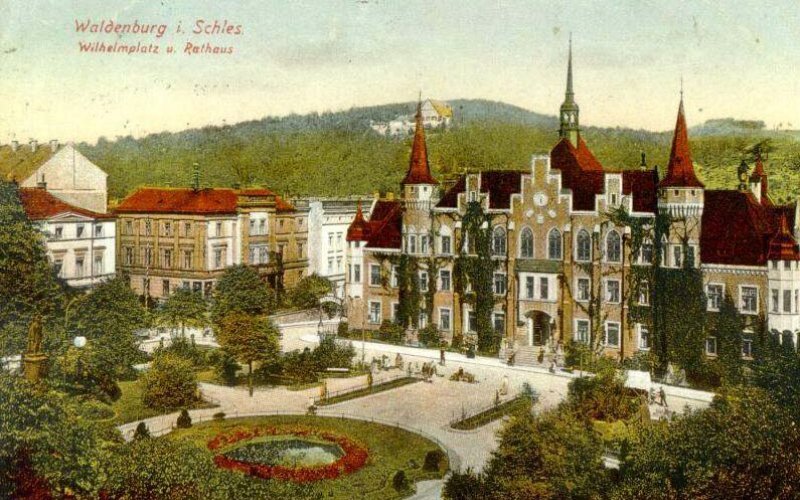History of Wałbrzych
The beginnings of Wałbrzych date back to the 12th century. In 1305, it was mentioned for the first time in writing, although still as a parish named Waldenberc, remaining a property of the Duchy of Świdnica-Jawor. However, according to the chronicler from Świdnica – Ephrain Ignatius Naso – a forest settlement existed here as early as in 1191. The name of the town was supposed to have been derived from pilgrimages to the wooden church with the therapeutic water spring, located on the hill, or an old settlement in the woodlands.
First residents of the settlement hunted, kept bees and cut trees to provide fuel and building material. Farming, craftsmanship and cattle breeding developed over time. On today’s Aleja Wyzwolenia, the cattle were rounded up, while the current Konopnickiej street was built up with barns.
Since 1278, the history of Wałbrzych was closely connected to the events in the Duchy of Świdnica, and later the Duchy of Świdnica-Jawor. The Piast rule brought the construction of tremendous strongholds and fortified towns, including the Książ Castle, Nowy Dwór, Rogowiec, Radosna, Grodno as well as Strzegom, Świdnica and Mieroszów, which were intended to guard the Duchy against the Bohemian attacks. At that time, the extraction of silver, lead and hard coal was initiated. According to the infrastructure footprint, the first mines were located on the slopes of the Ptasia Mountain. In the vicinity of the today’s railway station ‘Wałbrzych Miasto’; there were spouting mineral springs (already mentioned as early as in 1375), while the Old Spring (Altwasser) developed into a popular health resort at the turn of the 19th century.
In 1382, Wałbrzych became the fiefdom of the Schaff family, who was later known as the Schaffgotschs. In 1392, the demise of Duchess Agnieszka, Duke Bolek II’s widow, concluded the reign of the Piast dynasty over the area. Despite the reluctance to recognize the Czech rule, Emperor Charles IV – concurrently being the King of Bohemia – managed to seize the Duchy of Świdnica-Jawor on the ground of earlier agreements.
Between 1402 and 1426, Wałbrzych obtained town privileges. For a short period of time, the estate remained in the possession of Johann Liebenthal and became the property of the von Czettritz family in 1434. In the second half of the 15th century, it was passed from hand to hand, being owned by the King of Hungary Matthias Corvinus, Władysław Jagiellończyk and, as the pledged property, Fabian von Tschirnhaus from Bertelsdorf. In 1492, Wałbrzych once again became the property of the von Czettritz family and remained in their possession for almost 250 years.
At the turn of the 16th century, Wałbrzych suffered from the Hussite Wars, fights in Silesia, robberies committed by knights and brigands, devastation of castles and villages as well as various disasters and plagues.
The period of economic growth and the reconstruction of Wałbrzych began in the 16th century. At that time, the town benefited from the development of the weaving industry. Due to the Thirty Years’ War as well as plagues and disasters, the 17th century marked another difficult period in the history of Wałbrzych.
In 1739, the town was purchased for forty thousand Thalers by the Hochbergs, who resided at the Książ Castle. Their rule was retained until 19th November 1808, when an edict of the King of Prussia abolished the private ownership of towns and established town councils.
Once the Napoleonic Wars were over, Wałbrzych turned around and started to flourish. The town was connected to the railway, mines and coking plants developed rapidly, numerous public and industrial facilities were erected, imposing tenement houses were constructed, while the network of streetcar lines facilitated the public transport. Many factories started to operate at that time, including the mechanical spinning mill (1818), the ‘Huta Karol’ mechanical equipment manufacturing plant (1820), the ‘Krzysztof’ and ‘Wałbrzych’ porcelain factories (respectively 1829 and 1845), and the glass-works (1868).
Wałbrzych and its residents were not directly afflicted by World War I and World War II. After World War II, the displacement of the Germans took place. They were replaced by the Poles, who arrived from the eastern lands, that had formerly belonged to the Second Republic of Poland, and the central Poland as well as by the repatriates, mostly miners, who came back from France, the Westphalia and Belgium.
The post-war Wałbrzych underwent the lively cultural and social development. The spatial arrangement of the city was also altered at that time. Successive districts were incorporated into the administrative borders of the city, including Podgórze, Stary Zdrój and Biały Kamień. New housing developments were constructed, the biggest of which are Piaskowa Góra and Podzamcze.
After 1990, the liquidation of the mine and coking plant was initiated. Nowadays, the industry of Wałbrzych relies mainly on ceramics, automotive and clothing factories as well as the production of building materials. In 1997, the Special Economic Zone was created on the outskirts of the city, where numerous renowned companies, both domestic and international, operate until today.
The image of Wałbrzych has significantly changed over the recent years. Today, it is a modern city, full of greenery and attractive to tourists.
Autor: Katarzyna Matuła
Powrót do listy


